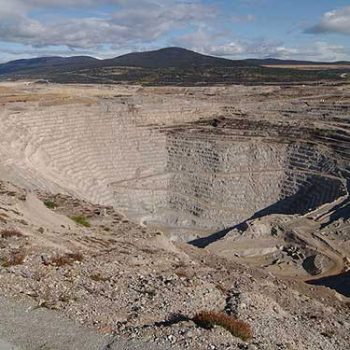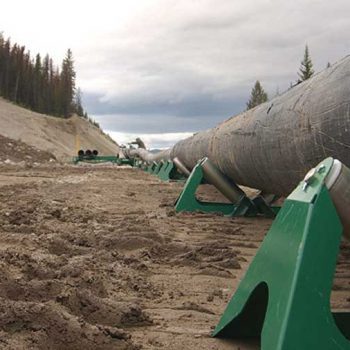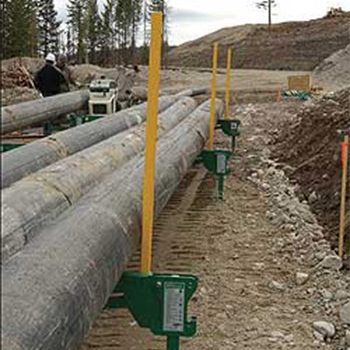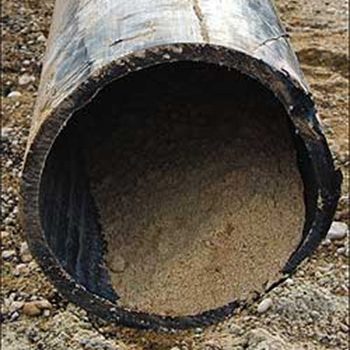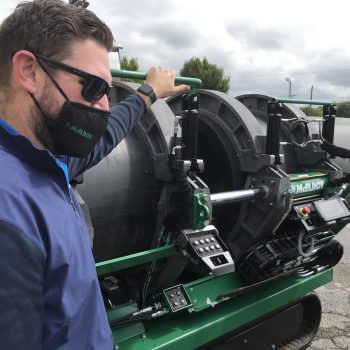Riding around Highland Valley Copper’s 34,000 hectares in south central British Columbia, it’s not uncommon to see miles and miles of black high-density polyethylene pipe (HDPE) weaving along the long, curvy work roads. In fact, a visitor to the copper and molybdenum mine would be challenged to find part of the landscape where HDPE wasn’t present above ground or below.
That’s because HDPE has been the pipe material of choice for many years at Canada’s largest non-ferrous metal mine.
Out of approximately 800 total employees, it’s a small group of 12 pipe-fitters and four apprentices laying and fusing pipe that makes the mine’s production possible. While they may never touch the copper and molybdenum directly, the pipe-fitters handle the 4″ to 36″ HDPE that spiderwebs under and across the Canadian landscape, keeping Highland Valley Copper operating at optimum levels.
Polyethylene pipe has a firm footing within the World’s oil, gas and water infrastructures, and it isn’t altogether uncommon in the mining industry. However, the challenges of Highland Valley Copper’s HDPE usage are unique. It’s in the mine’s pipe systems where the thermoplastic pipe gets called into service to carry liquids, gases and even rough solids, such as slurry.
At Highland Valley Copper, HDPE is used in eight different material-handling scenarios:
- Discharge tailings pipelines carry away a slurry mix of half water and half sand/rocks .
- Water supply pipelines provide water to Highland Valley Copper’s mill in order to complete mining processes.
- Culvert pipes deal with the water and snow runoff typical of the Rocky Mountains, so as to not disturb mining operations and the large roads created for the trucks and machinery.
- Sump basin discharge pipelines control ground-water seepage and dam leakage.
- Contaminated water discharge pipelines separate bad water from good.
- Pump discharge lines.
- Potable water lines for the mine and mill, so employees have clean drinking water as well as bathroom resources.
- Conduits for electrical lines traversing under crossings and road passages.
In a setting where time is money, HDPE has served a need – keeping pipe networks and systems in top shape by remaining sturdy, strong and answering the demands of the Canadian mining environment.
We put polyethylene pipe through hoops you don’t see all the time
“We put polyethylene pipe through hoops you don’t see all the time,” explains John York, mill shop planner at Highland Valley Copper. “I started here in 1983, and we still have pipes from 1983 in use.”
York’s emphatic satisfaction with the pipe is due to the versatility of the material. The reapplication of used pipe to other parts of the premises is also a benefit at the environmentally conscious mine, as pipe not deemed worthy of slurry discharge duty might be capable of protecting electrical lines or operating as a culvert pipe.
Popular in infrastructures where ground movement, such as earthquakes, is possible, HDPE has some flexibility that allows the Highland Valley Copper crew to line the curved roads with the pipe, as well as go up, over and around contours in the earth. The allowable bending radius of HDPE has proven to be 20 to 25 times the outside diameter of the pipe.
While some pipe materials are poor choices for certain temperatures, Highland Valley Copper and nearby Logan Lake, British Columbia, are in a semi-arid climate that can experience temperatures as low as -30° C (-22° F) and as high as 40° C (104° F) within a calendar year. The nature of the resin in polyethylene pipe keeps it from cracking at the extreme lows, and moves with the ground as the soil around the pipe freezes and thaws.
Keeping up with the eight uses for HDPE at Highland Valley Copper is a full-time job for York’s crew. However, the hours put into the pipe work is beneficial because the pipe’s properties refuse rust, rot and corrosion; the heat-fused joints create a homogeneous leak-free system; the pipe can withstand various surge events; and the pipe requires fewer fittings due to HDPE’s flexibility.
Environmental Initiatives
When the slurry discharge lines become compromised or worn down from solids rushing through them, the team can easily turn off a pipeline and remove the damaged pipe. It’s simple and cost effective to cut out the section of pipe, replace it and be back in service in a matter of hours, not days. The reuse of materials saves Highland Valley Copper money, as well as keeping a product that is designed not to biodegrade from reaching landfills.
The recycling of the pipe is just one aspect of the environmental focus of Highland Valley Copper and their parent company, Teck Cominco.
In 2006, the mine began advancing two energy efficiency projects. The first project involved an upgrade of the outside lighting on the property, in efforts to replace inefficient fixtures and place sensors to reduce use during the day.
The second project involved the pipe-fitters, as HDPE pipelines are being created to increase the efficiency of the system used to recycle processed water from the tailings pond to the mill.
The completion of both projects is expected to result in energy savings of more than 10 GWh per year.
How Highland Valley Copper Makes HDPE Work
Of the miles of 4″ to 36″ diameter pipe at Highland Valley Copper, the effectiveness and stability of the pipe network comes down to the connecting procedure referred to as butt fusion.
Pipe fusion is a process that joins two pieces of thermoplastic pipe together with heat and pressure. The butt fusion process starts by “facing” or shaving the pipe ends simultaneously so that they can be joined together with heat to create a continuous, sealed pipeline. The welding of the pipes is accomplished by using a hot plate in contact with the pipe ends, which heats the plastic to a molten state. Then, after its removal, the ends are pressed together under a controlled force to form a weld that is stronger than the pipe itself. Third-party water industry research indicates that HDPE pipe and joints can have a lifespan of more than 100 years in water and gas infrastructures. York estimates that the mine gets a fraction of that performance in slurry lines, which is exponentially better than other pipe materials that could be used.
While pipes can be joined together in numerous ways, fusion creates a joint that is as strong and leak-proof as the pipe itself, when fused properly. The quick, time-effective fusion process isn’t the only productivity lesson the dozen pipe-fitters at Highland Valley Copper have picked up over the years.
On a September day in 2008, pipe-fitters Dennis Schmidt and Todd LeDoux were working on a rain and snow runoff line that utilized decommissioned 18-inch DR 17 tailings pipe. The fusions were performed with a McElroy TracStar 618 fusion machine paired with a PolyHorse and prototype Low Profile Rollers.
The McElroy PolyHorse is a pipe-handling system designed to give significant productivity gains when installing 3″ IPS to 20″ OD (90mm – 500mm) HDPE pipe. In the case of Highland Valley Copper, the PolyHorse was able to cut down on manpower, as well as diesel equipment, required to maneuver pipe into position for fusions. The pipe can be loaded onto the PolyHorse straight from the truck, where the fusion operator can then roll the pipe into place by himself.
McElroy’s Low Profile Rollers gave Schmidt and LeDoux the opportunity to fuse long lengths of pipe together that could then be pulled to their final destination. The rollers kept the already beaten and battered pipe from being further damaged by the rocky landscape. The pipe could then be pulled by a standard pick-up truck, instead of heavy machinery.
The PolyHorse and Low Profile Rollers have both become staples for Highland Valley Copper’s efficient pipe-fusion program. The mine recently received 88 truckloads of fresh 18-inch pipe (more than 7 kilometer’s worth) to be utilized in a water supply line for the mill. The pipe-handling tools will increase the number of joints created per day, so the workers can move on to one of the mine’s other HDPE needs.
Obviously, the amount of copper and molybdenum pulled out of the mine is of biggest concern to Highland Valley Copper’s bottom line. However, York’s crew, the extensive network of HDPE pipe, and the continued productivity gains that might be considered the unsung heroes that keeps the mine operating efficiently.
